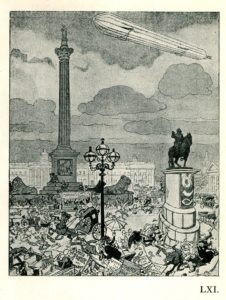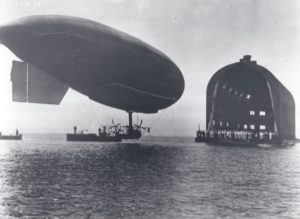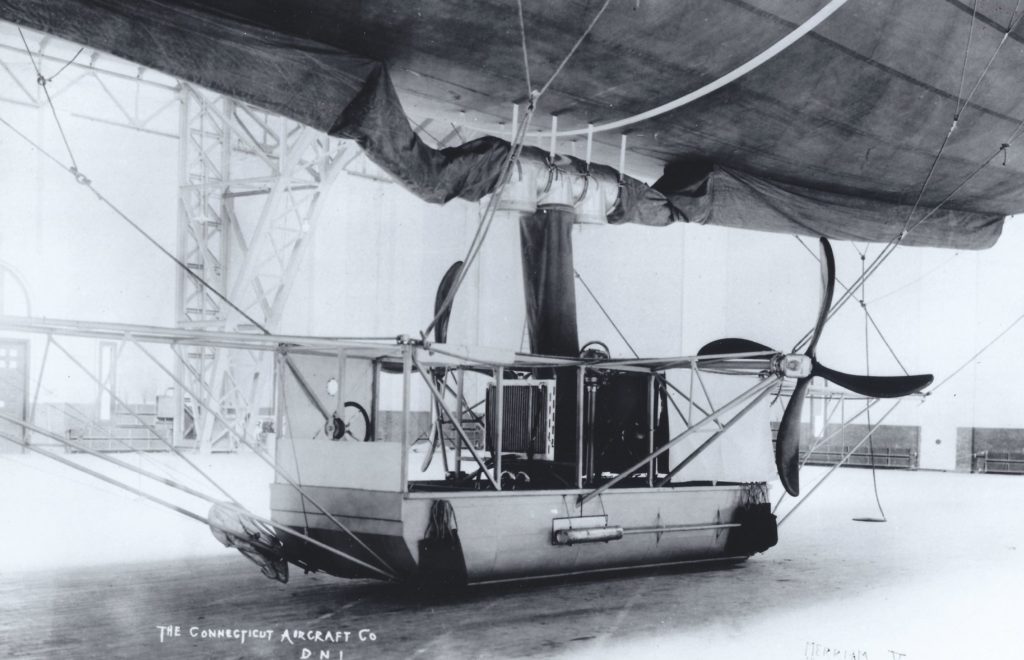By Elizabeth Correia
The United States military’s experience with lighter-than-air technology began with the Connecticut Aircraft Company’s DN-1 airship built for the navy in 1917. The navy ordered construction of the DN-1 following Germany’s success with zeppelin air raids. The Connecticut Aircraft Company ultimately proved unable to meet military combat standards and the navy delegated the DN-1 for use as a training ship. Nevertheless, the Connecticut Aircraft Company, as the first American company to construct a military airship, paved the way for highly successful airship engineers that followed.
“Zeppelinphobia”

A German cartoon of a zeppelin over London with a panicked crowd below. Source: H. Pearl Adam, International Cartoons of the War (New York: E. P. Dutton & Co., 1916), n.p., – Connecticut State Library.
Germany was at the forefront of lighter-than-air aviation in the early 20th century due to the Swabian Count Ferdinand Graf von Zeppelin’s engineering success. The first zeppelin, or rigid airship built by Count Zeppelin’s company, was completed in 1900. By the start of World War I Germany had 18 zeppelins, each equipped with machine guns and torpedo launchers.
The military potential of zeppelins became evident on August 25, 1914, when the Germans launched an air raid on Antwerp, Belgium that resulted in the deaths of ten civilians. Suddenly nations separated from the continental war by leagues of ocean now seemed much less isolated. As a result, the United States began experimenting with developing their own lighter-than-air arsenal.
The Connecticut Aircraft Company and the DN-1
In April 1915, four companies bid on a contract for the construction of the United States Navy’s first dirigible, later named the DN-1 (as in “Dirigible Non-rigid Number 1”). The four companies were Stanley Yale Beach of New York, American Dirigible Balloon Syndicate of New York, the Goodyear Tire and Rubber Company of Ohio, and the Connecticut Aircraft Company of Connecticut.
The Connecticut Aircraft Company received the contract for the DN-1 on May 14, 1915, largely because of their low bid. At this time, the company had only been operating for about two years under the leadership of lawyer Samuel Moorehouse and businessman Ed Mullikan. Chief Engineer James F. Boyle was the only employee with balloon experience, and that consisted of just one flight. After receiving the contract, the company hired four engineers to assist Boyle, as well as a number of women to sew balloon envelopes in the company’s factory at 136 Haven Street, New Haven.
Once completed, the Connecticut Aircraft Company transported the DN-1 to a floating hangar in Pensacola, Florida, for trial flights that began on April 20, 1917. The DN-1, unfortunately, sank during its first trial, but was rescued and lightened for additional flights. Hans Stagel flew the DN-1 for its second trial, thrilling onlookers with his skilled piloting. James Boyle later admitted that Stagel’s flight was far from a success:
We had to make 35 mph to qualify, and we could only do 30. So Hans went way out near the horizon and pointed it downhill and we made it. Then he did some fancy maneuvers that drew applause from the spectators on shore. He would fly along, dip down to the water, and rise again. When he came in he told me those were not for show; he had to dip down to scoop up pails of water to dash them on the transmission because a bronze bearing had overheated, melted, and the metal was running out like a river!
Even with its shortfalls, the US Navy accepted the DN-1 as a training vessel. After a few flights, however, the DN-1 was damaged and never repaired. Undaunted, the Connecticut Aircraft Company continued to complete contracts for the US Navy (manufacturing balloons and working on B- through H-type airships) until closing its operations in 1921.
US Navy Airships after the DN-1

The DN-1 at the Pensacola, Florida floating hangar on April 27, 1917. – Courtesy of the New England Air Museum, Windsor Locks, CT
After the DN-1 trials, the United States Navy did not give up on airships. The DN-1 was designated as the only A-type airship, but the navy contracted out 16 new B-types in March of 1917 to serve as naval scouts, and in 1918, ordered C-type airships capable of destroying submarines with depth charges.
The US Navy completed the country’s first rigid airship in July 1919. It was named the ZR-1 for “Zeppelin Rigid Number 1,” taking its name from the German airships that terrorized Allies during World War I. The navy used these rigid airships to scout beyond the American coastline since they had greater endurance capabilities than non-rigid airships. But by World War II, the US military’s preferences shifted from rigid airships to airplanes, due to their greater maneuverability. The navy ultimately terminated its lighter-than-air program in 1961.
Elizabeth Correia holds an MA degree in Public History from Central Connecticut State University and works in cultural resource management.










